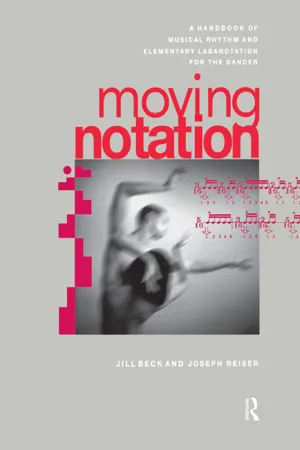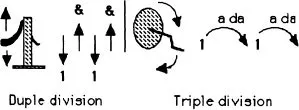
This is a test
- 373 pages
- English
- ePUB (mobile friendly)
- Available on iOS & Android
eBook - ePub
Moving Notation
Book details
Book preview
Table of contents
Citations
About This Book
Designed specifically for university-level study, Moving Notation will benefit students and teachers of both dance and music, offering a complete introduction to the theory and practice of musical rhythm and elementary Labanotation. Performing Arts Studies aims to provide stimulating resource books of both a practical and philosophical nature for teachers and students of the performing arts: music, dance, theatre, film, radio, video, oral poetry, performance art, and multi-media forms.
Frequently asked questions
At the moment all of our mobile-responsive ePub books are available to download via the app. Most of our PDFs are also available to download and we're working on making the final remaining ones downloadable now. Learn more here.
Both plans give you full access to the library and all of Perlego’s features. The only differences are the price and subscription period: With the annual plan you’ll save around 30% compared to 12 months on the monthly plan.
We are an online textbook subscription service, where you can get access to an entire online library for less than the price of a single book per month. With over 1 million books across 1000+ topics, we’ve got you covered! Learn more here.
Look out for the read-aloud symbol on your next book to see if you can listen to it. The read-aloud tool reads text aloud for you, highlighting the text as it is being read. You can pause it, speed it up and slow it down. Learn more here.
Yes, you can access Moving Notation by Jill Beck,Joseph Reiser in PDF and/or ePUB format, as well as other popular books in Media & Performing Arts & Dance. We have over one million books available in our catalogue for you to explore.
Information
1
GETTING STARTED
RHYTHMIC CONCEPTS

1.1 Time
“Time is nature’s way of keeping every thing from happening at once.”
Woody Allen
As we all know, time is continuous. In traditional music, time’s continuity is divided into units called beats. Beats (sometimes referred to as pulses) are nothing more than divisions of time.
Beats are not always regular – beats can also change speed. The fascinating thing about beats and speed is that as you listen to them being measured on a metronome, the sound (click) you hear marks only the beginning of the beat. It is the length of time between the clicks that determines the beat’s speed. So, when you use the term “beat”, think of the entire “duration” of the beat and not just the click.


1.2 Beat Divisions (Sub-beats)
There are only two subdivisions of beat: a duple division and a triple division. Duple beats are those which are divided into equal halves and are counted 1 &, and triple beats are divided into equal thirds and are counted 1 a da:

When you count 1 &, the “and” indicates the duple division of the beat. When you count 1 a da, the “a da” indicates the triple division of the beat. Notice also that the duple beat looks and feels square, while the triple beat feels round, the difference between pumping a pump and turning a wheel:



1.3 Rhythm versus Beat
The difference between rhythm and beat is generally understood as that which changes and that which does not: rhythm adds a flexible variety of changing sounds against a landscape of regular beats. This definition, while not a “law”, does cover a wide range of “rhythmic reality”.
Traditionally, beat and rhythm go hand in hand. A beat is selected at a particular tempo and then rhythm is added “to” the beat, “over” the beat, “on top of” the beat. In this manner, beats become the architectural pillars upon which rhythm is supported:

There are only three ways in which rhythmic durations can relate to a beat:
(1) Thru-beat. The rhythm’s duration is longer than the beat, thereby sustaining through the end of one beat into the next. Call this a “thru-beat rhythm”.

(2) Full-beat. The rhythm’s duration is the same size as the beat. Call this a “full-beat rhythm”.

(3) Sub-beat. Each rhythmic duration is shorter than the beat. Call this a “sub-beat” rhythm:

The United States National Anthem reveals all three rhythmic activities in the opening musical line:


In any given musical composition all three categories of rhythmic duration will be present, although composers will from time to time employ one type exclusively for effect. For example, exclusive thru-beats can sound suspenseful, sad, or languid. Exclusive full-beats can sound march-like. Exclusive sub-beats can sound agitated or exciting.


Table of contents
- Cover
- Half Title
- Title Page
- Copyright Page
- Dedication
- Table of Contents
- Introduction to the Series
- Acknowledgements
- Introduction
- 1 GETTING STARTED
- 2 GETTING ORGANIZED
- 3 FIRST EXPANSIONS
- 4 APPROACHING PERFECTION
- 5 2’S AND 3’S
- 6 UPSETTING THE BALANCE
- 7 CHANGING TIMES
- 8 CONCLUSIONS
- Appendix A
- Appendix B
- Index